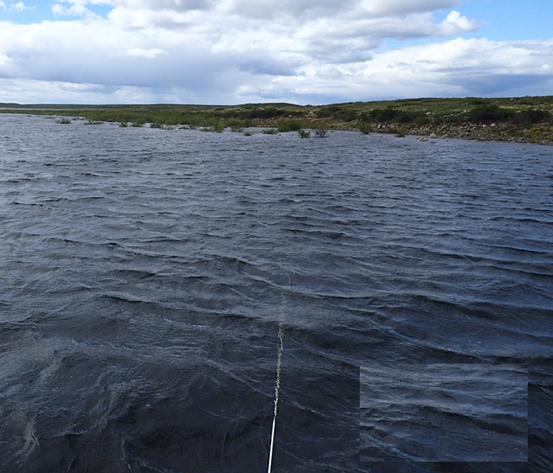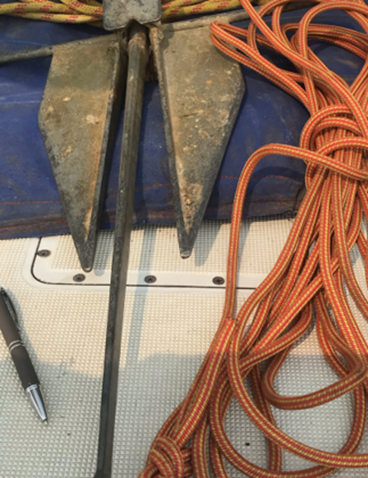By Dave Olessen, a 14,000-hour bush pilot based at Hoarfrost River, Northwest Territories. He owns and operates a Part 702 and 703 Commercial Air Service
“If you wanted to design a really lousy boat, it would end up looking a lot like a floatplane!”
Photo taken from the deck of the left float. Bush Hawk holding fast at anchor.
That is a declaration I trot out when I am giving pre-flight safety briefings to my floatplane passengers and customers. At the start of a floatplane flying gig, it serves us all well if I remind them about the constraints of our beloved flying boats. Constraints such as: extreme sensitivity to winds and currents; the challenges of getting into shallow water and getting people onto shore; the challenges of planning to pick people and gear up at a specific location, later on, not knowing what the wind and wave conditions will be by then, and so on.
A lot of my work in the Northwest Territories (NWT) and Nunavut involves multi-day contracts with “-ologists” of various disciplines–hydrologists, geologists, seismologists, biologists, etc. I often start a job by reminding these people that in a piston-engine floatplane there is usually only one direction of movement, and that is forward. From the moment the prop begins to spin, and the “floating boat” is set free of its tethers, it is an awkward single-minded beast obsessed with only one path: ahead!
Many floatplane pilots are also enthusiastic sailors, cruisers, and paddlers. They love water, the interplay of wind and water, the movements of waves and currents, and all the other delights of physics that boating and float-flying allow us to sample. Given that enthusiasm, I am surprised by the blank look I almost always get from other float pilots when I mention the topic of anchoring, or anchors, or some neat trick that the clever use of an anchor (or two) has made possible in a day’s work.
An anchor and rope with a foam-lined blue cloth bag, to be carried in the pilot side float compartment
“Anchor? You carry an anchor?”
“Oh yes, and often two. And plenty of rope.”
The need for rope, they get that. The paddle, also. In these enlightened times full-time life jackets are mandatory equipment. We take Underwater Egress Training, and most of us would not leave the dock without some bug dope, some basic survival gear, an axe, some waterproof matches and fire-starters, a small tool kit, a tarp, and so on.
But an anchor? “Isn’t that really heavy?” fellow pilots ask. Picturing, perhaps, the 35-pound CQR dangling from the yachts at the local marina. An anchor does weigh something, yes. So do ropes, tool kits, your lunchbox, and the survival kit. The eight-pound Danforth anchor I depend on in our Found Bush Hawk (gross weight 3800 pounds on floats) accomplishes so much for me in a day’s work that I would never consider setting off without it.
What does an anchor do for a floatplane pilot? In a nutshell, it gives the captain of that single-minded forward-motion beast the option of stopping and staying put on the water. In a floatplane, the option of stopping and staying put on the water is an absolute game-changer.
This being the Aviation Safety Letter, we can focus on the safety aspects of carrying an anchor and knowing how to use it. A dozen or more scenarios leap immediately to mind. For instance, the nightmare of an engine that has just quit while taxiing in or out from shore on a big remote lake, with a brisk offshore wind eager to push the airplane out into miles of open water. And out there—where the suddenly quiet plane is rapidly being pushed—the waves just get taller and taller, the water gets deeper and colder, and, well, like I said, it is a nightmare. Unless you can scramble out, drop anchor while the bottom is still in reach, and Stop!
I came to the aid of a fellow pilot one day, who had just made a smooth dead stick landing in a Turbine Single Otter on a tundra lake north of my home base. It was a bluebird summer day, and at first, I was not sure what was going on. I taxied to within shouting distance of the Otter, where the pilot and his swamper were standing out on the floats. The plane had drifted downwind on the steady eight-knot breeze, and it was being crunched into a nasty cove of jagged boulders. Without an anchor, where else was the powerless boat going to end up? (Not a trick question.)
I shut down my engine and stepped out onto my float, pulled the anchor bag and coil of rope out of the float compartment, tossed out the anchor and made the line off to the float ballard. We shouted back and forth, and the first thing he said was, “Good idea, that anchor!”
I think I can just stop the stories there. I could go on all day.
One further important point on the topic of carrying an anchor is to be sure to carry it in a padded bag of some kind. My anchor bags are just simple durable sacks sewed up at home, lined with closed-cell foam. The anchor slides quickly in and out, and its sharp edges are padded from damaging the interior of the float compartment. The bag also keeps any muck from the anchor tines from dirtying the inside of the compartment or the plane.
Oh, and there is this: I have spent many a fine afternoon over the past 30 years drifting gently at anchor, napping or reading on the smooth top of a float, a little ways offshore and away from the insect hordes, waiting for hours for “-ologist” customers to come sweating back across the tundra with their hammers and bags of rocks or their plant samples. Then I just ease out the anchor line, let the plane drift in toward shore, and we load up. Pull back out, lift and stow the anchor, and off we go.
Try carrying an anchor in your flying boat. You will like what it can do. And it just might save your bacon.

